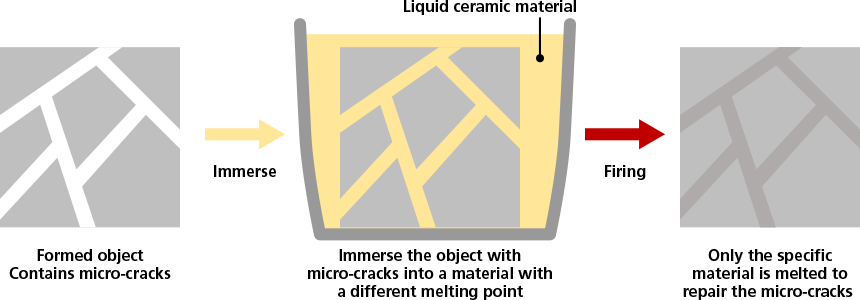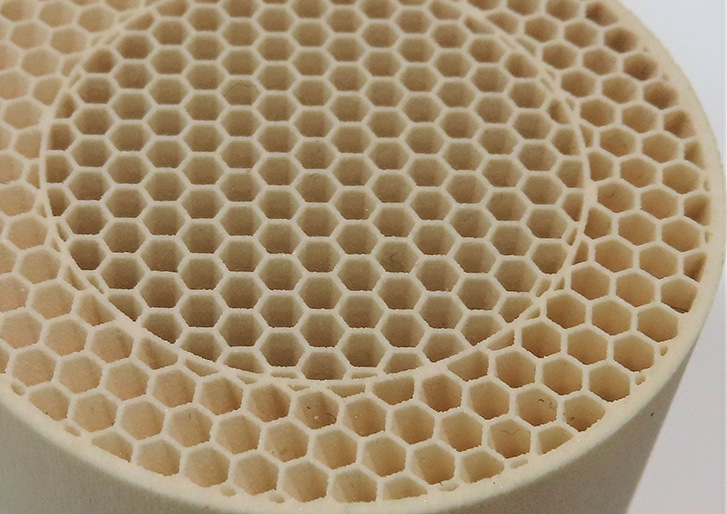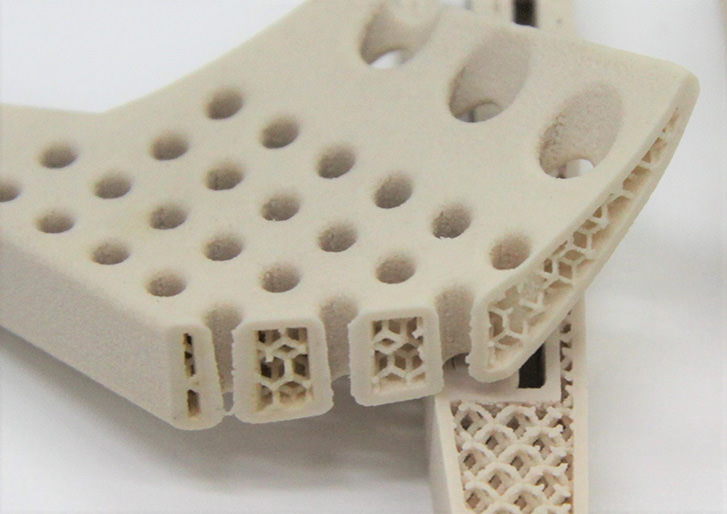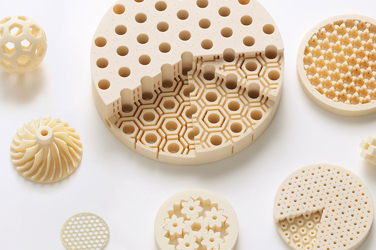Developers' Story
Out-of-the-box thinking removes obstacles to the potential of ceramics
- Setting an aim
- Challenges
- Effective use of knowledge
- Out-of-the-box thinking
- Sharing resources
- Towards the next stage
In advanced industries, there is growing demand for the 3D printing of high-performance ceramic parts. Canon succeeded in the development of a new material of ceramics for high-precision shaping, overcoming difficult challenges. It was Canon's breadth of business and out-of-the-box thinking, born out of the culture of its development organization where novel ways of thinking were encouraged, that allowed it to do so.
Setting an aim
Keeping an idea with future potential burning with a 0.4-person team
Mention 3D printing, and most people think of its use by hobbyists to create figurines or models. However, such uses pale in comparison to their fast-expanding application in industrial fields, such as for product prototyping and small-lot production of parts. Canon had been eyeing the growing 3D printing market and was exploring the possibility of entering it.

Nobuhiro Yasui (left)
General Manager, R&D Headquarters
Founding member of the 3D printing ceramic material element development team
Rika Sawano (right)
Frontier Business Promotion Headquarters
Team member promoting the commercialization of ceramic materials for 3D printers.
*Affiliation is as of the time of the interview.
Research and development of 3D printing ceramic materials is currently ongoing at the Core Technology Development Headquarters.
- Why did you focus your attention on ceramic materials?
The story started when we found a proposal titled "3D printer consumables business," which was submitted to a call for new business ideas that all R & D headquarters members could apply for, and we became interested in the proposal because Canon's technology and know-how could be used there. When it comes to ceramics, we are all familiar with items such as bowls and tableware. However, ceramics are also widely used in equipment in cutting-edge fields such as semiconductors, automobiles, and medicine because of their superior properties such as heat resistance, insulation, and corrosion resistance, which materials like resins and metals do not have.
Our research also indicated that the market for ceramic materials was about to take off. As a material, ceramics are extremely hard and difficult to process by cutting or shaving. Therefore, we thought that if we could use 3D printers, which could shape complex, highly flexible forms, they in turn could be used for various needs.
At the time, I was also in charge of another development project, so I didn't have much time to spare. However, I felt it was too good an opportunity to let fall by the wayside, and so decided to start working on it. We had three developers on the team. Each team member was also working on other development projects at the same time, so the actual total number of people working on this project was about 0.4 people: a very modest beginning. At the same time, developing ceramic materials for 3D printers required overcoming a number of major challenges.
Challenges
Standing a chance precisely because no others have succeeded
There are several methods for printing 3D ceramics. When Canon started exploring the technology around 2016, the most widely used method was to mix resin into the ceramic material as a binding agent. However, the resin evaporated during the firing, which caused the ceramic to shrink significantly, making precision inconsistent. In some cases, long firing times were also required.
Therefore, we decided to investigate a method known as “selective laser melting,” whereby a laser beam is used to directly melt the powdered material, which does not contain resin, and form the desired shape.
With this method, shrinkage during firing can be sufficiently controlled. This not only significantly shortens the firing time, but also can be done using existing general-purpose equipment used in metal 3D printing. Many researchers and developers had already been working on this method and published a number of academic papers, but they were all struggling with issues unique to this method.
Nobuhiro Yasui
Spent many years working on the development of inorganic materials including ceramics. Involved in the development of inorganic materials used in materials in X-ray imaging sensors.

There were two major hurdles we had to overcome to achieve our objective. The first was with the material, which did not melt sufficiently when heated with an infrared laser. The second was the formation of micro-cracks, which are micron-sized narrow gaps, in the formed product. I thought it would be extremely difficult to solve these issues by simply improving the performance of the 3D printer itself. Therefore, I decided instead to use a new material to solve the problems.
I have been developing ceramics and other inorganic materials for many years. Canon also has know-how in handling powder materials, which it has accumulated through the development of toner for printers. I felt that if we could make effective use of this knowledge, we would be able to overcome these hurdles. (Yasui)
Effective use of knowledge
Applying know-how in medical equipment materials
For the heating of the molding material, which was the first hurdle, we applied a type of scintillator material that was being developed at the time and was used in X-ray imaging sensors for medical equipment. I knew that the components in this scintillator material were capable of efficiently absorbing infrared rays. Therefore, I worked on the assumption that using this material powder to efficiently convert the energy of the infrared laser into heat would result in successful forming.
The melting point, that is, the temperature at which ceramic materials melt, is as high as 2000°C. Increasing the absorption rate of the infrared rays should technically enable “efficient melting”. When we used scintillator material whose powder state was controlled as a material, we were able to confirm that it could be formed with a general-purpose metal 3D printer.
Materials for X-ray imaging sensors and materials for 3D printers are very different fields, but Canon's accumulated knowledge of inorganic materials was usefully shared and utilized in overcoming this first hurdle.
Out-of-the-box thinking
Finding the optimal solution without being bound by conventional thinking
The second major hurdle was micro-cracks. A method for preventing the occurrence of cracks, which are micron-sized narrow gaps, already existed. This method requires heating forming environment so that the formed parts do not cool down suddenly. With this method, however, the formed object reaches a high temperature and takes a long time to cool. Furthermore, the surrounding material tends to clump together, making it difficult to achieve an accurate shape. I knew it would be difficult to overcome this problem by working on the materials. Instead, the micro-cracks would have to be repaired after the object was formed.
This entailed designing a process where the gaps are repaired by inserting ceramic material into the narrow gaps and melting it together with the surrounding material during firing. With this in mind, I selected a liquid ceramic material that would penetrate into the micro-cracks. Using this process, we were able to overcome the second hurdle by firing the formed ceramics after immersing them in liquid. Repairing the micro-cracks after the formation process made our material as strong as conventional high-performance ceramics.

The ideas of “having liquid soak into the micro-cracks” and “lowering the melting point of ceramics” are not particularly new, but Canon’s wealth of human resources with diverse backgrounds made it possible to skillfully combine these different methods to solve our problem.
Canon is an electronics equipment manufacturer, and therefore does not have many materials development engineers. In fact, there are very few ceramics experts. On the other hand, it could also be said that for that very reason we were able to continue to take on challenges without being hampered by so-called “conventional knowledge.” Of course, we had no intention of attempting what could not be done in principle, though. I feel that the wealth of technology and our strong culture of information sharing across organizations resulted in flexible thinking and the creation of new ideas. (Yasui)
Making the high-precision forming of complex shapes possible

Honeycomb structure (combination of helical and straight pores)

Application of a lattice structure
Sharing resources
An engineering team that develops materials with customers’ needs in mind
When developing materials, our engineers prototype, measure and analyze various formulations over and over again. This requires a metal 3D printer as well as various measuring and analyzing instruments for prototyping. In addition to 3D printers used for prototyping during product development, the Canon Group owns measuring instruments and analyzers for powder materials, as Canon also develops toner for printers. Having an environment that facilitates the use of these equipment across departmental boundaries was also a great advantage in development.

Rika Sawano
Has been involved in the development of ceramic materials for 3D printers since joining Canon. Mainly in charge of material analysis and measurement.
The initial phase centered around the research and development department, which developed the elemental technologies. We are now at the commercialization phase, led by the Frontier Business Promotion Headquarters which is responsible for creating new businesses.
To ensure stabler quality, strict control of the state of the powdered material is vital. There are many members in the Frontier Business Promotion Headquarters who are excellent in handling powder materials, and we are working to maintain and improve quality while achieving both material function and ease of use.
Instead of just mulling over ideas within our own department, get to nurture them into something bigger through collaborating with other departments based on the stage of ideation and technical development that we’re at. I feel that we have a wonderful environment for engineers. (Sawano)

As an engineer in the commercialization promotion department, she works on further improving of materials
Towards the next stage
Opening the doors to a future for ceramic 3D printing
At present, we are in constant communication with customers to further expand the possibilities of ceramic 3D printing through this new material. We initially believed the strength of our technology lay in the absence of shrinkage after firing. But as we engineers listened to our customers at exhibitions and other venues, we learned that some of them were attracted to the short delivery time, too. So, to meet the needs of our customers, we also developed a new material that can repair micro-cracks through firing in a short period of time without having liquid soak into the micro-cracks.
Because Canon has many teams that specialize in simulation and process technology, we are working at creating a system that enables us to rapidly supply high-value-added, high-performance ceramics while also making proposals for providing additional functions to the forms requested by our customers.
Interview, organization Kazuo Nakahara
Born in Hokkaido in 1982. Worked for a chemical manufacturer before turning photography as a profession. In addition to his work in advertising photography, he is also an instructor at photography workshops and seminars.
<After the interview>
Canon's know-how has created various groups of products. I was impressed to learn that this know-how knowledge is shared across the boundaries of fields and departments at Canon to create new products and technologies. I hope that Canon will continue to develop innovative technologies by taking on challenges where it is not bound by “conventional knowledge.”
Firing
The process where heat is applied to harden the material after it is shaped with a 3D printer.


